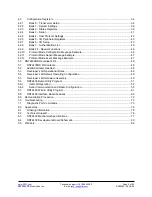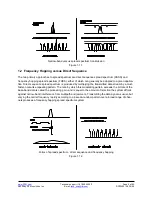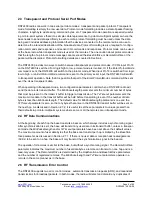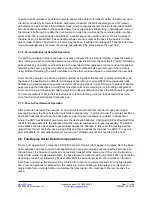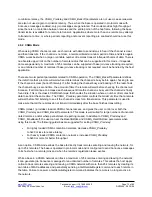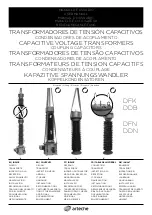
www.RFM.com
Technical s1.678.684.2000
Page 7 of 82
©2009 by RF Monolithics, Inc.
E-mail:
DNT2400 - 08/18/09
One disadvantage of direct sequence systems is that due to design issues related to broadband transmit-
ters and receivers, they generally employ only a minimal amount of spreading, often no more than the
minimum required by the regulating agencies. For this reason, the ability of DSSS systems to overcome
fading and in-band jammers is relatively weak. By contrast, FHSS systems are capable of hopping
throughout the entire band, statistically reducing the chances that a transmission will be affected by
fading or interference. This means that a FHSS system will degrade gracefully as the band gets noisier,
while a DSSS system may exhibit uneven coverage or work well until a certain point and then give out
completely.
Because it offers greater immunity to interfering signals, FHSS is often the preferred choice for co-located
systems. Since direct sequence signals are very wide, they can offer only a few non-overlapping chan-
nels, whereas multiple hoppers can interleave, minimizing interference. Frequency hopping does carry
some disadvantage, in that it requires an initial acquisition period during which the receiver must lock on
to the moving carrier of the transmitter before any data can be sent, which typically takes several sec-
onds. In summary, frequency hopping systems generally feature greater coverage and channel utilization
than comparable direct sequence systems. Of course, other implementation factors such as size, cost,
power consumption and ease of implementation must also be considered before a final radio design
choice can be made.
2.0 DNT2400 Radio Operation
2.1 Network Synchronization and Registration
As discussed above, frequency hopping spread spectrum radios such as the DNT2400 periodically
change the frequency at which they transmit. In order for the other radios in the network to receive the
transmission, they must be listening to the frequency on which the current transmission is being sent. To
do this, all the radios in the network must be synchronized to the same hopping pattern.
In point-to-point or point-to-multipoint networks, one radio module is designated as the base. All other
radios are designated as remotes. One of the responsibilities of the base is to transmit a synchronization
signal (beacon) to the remotes to allow them to synchronize with the base. Since the remotes know the
hopping pattern, once they are synchronized with the base, they know which frequency to hop to and
when. Every time the base hops to a different frequency, it immediately transmits a synchronizing signal.
When a remote is powered on, it rapidly scans the frequency band for the synchronizing signal. Since the
base is transmitting on up to 37 frequencies and the remote is scanning up to 37 frequencies, it can take
several seconds for a remote to synchronize with the base.
Once a remote has synchronized with the base, it will request registration information to allow it to join the
network. Registration is handled automatically by the base. When a remote is registered, it receives
several network parameters from the base, including HopDuration, InitialNwkID, FrequencyBand and
Nwk_Key (see Section 4.2 for parameter details). Note that if a registration parameter is changed at the
base, it will update the parameter in the remotes over the air.
Among other things, registration allows the tracking of remotes entering and leaving a network, up to a
limit of 254 remotes. The base builds a table of serial numbers of registered remotes using their three-
byte serial numbers (MAC addresses). To detect if a remote has gone offline or out of range, the registra-
tion is “leased” and must be “renewed” once every 250 hops. Any transmission from a remote running on
a leased registration renews the lease with the base. If a remote does not transmit within 250 hops, the




